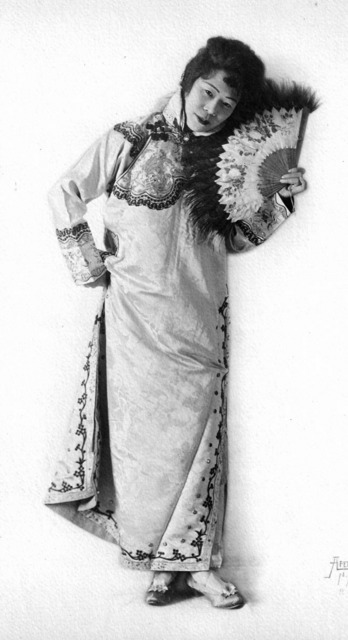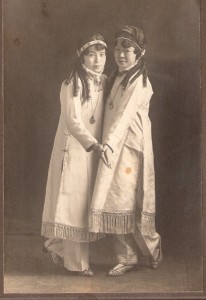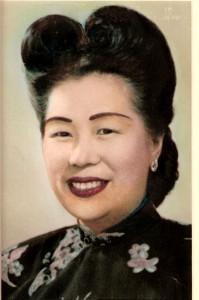The existence of a figure like Marion E. Wong challenges the received narrative of American film industry history in which Anglo-American men started the majority of the first companies and the participation of Asians was limited to providing exoticism on screen as actors or extras. If we were to look to the New York Times as a definitive source, we might conclude that only one Chinese-American company existed in the silent era and that that company was started in 1922 by James B. Leong. According to the Times, Leong financed the Wah Ming Motion Picture Company in order to produce “picture-plays of, by, and for the Chinese” (69). However, five years before and with the same goal in mind, a young Chinese-American woman had started the Mandarin Film Company in Oakland, California. We know now that she was not only president of the company, but also screenwriter, director, and costume designer. Until recently, however, the name Marion E. Wong was known to scholars only from a small note in the back pages of a 1917 issue of the Moving Picture World. The article mentions the Mandarin Film Company and heralds their first multiple-reel feature film, The Curse of the Quon Gwon: When the Far East Mingles with West (1916), as the first and only film made by an all-Chinese cast and an all-Chinese company (63).
The achievements of Marion E. Wong were unusual enough to attract the attention of several local newspapers, most notably the Oakland Tribune. In the first of two articles, Wong reveals that she is determined to introduce to the world Chinese motion pictures with “some of the customs and manners of China” (1916). Sounding confident about her venture, she is quoted as saying that if the first picture was successful, her company would continue “exclusive productions.” The next year, in 1917, the Oakland Tribune describes Marion E. Wong as “energy personified,” a Chinese girl with “imagination, executive ability, wit and beauty.” According to the same article, Wong constructed a temporary studio at the rear of her home and rented camera equipment from a “special picture concern in Oakland.”After much negotiation with a businessman in Oakland’s Chinatown and with the support of her elder sister, whose husband was a rich merchant, Wong financed her Oakland-based company with the goal of producing Chinese-themed films. When interviewed, Wong always expressed enthusiasm for presenting Chinese culture to Westerners.
In a recent interview, the descendants of Marion E. Wong confirmed that she was the producer-director as well as the screenwriter of The Curse. She also cast herself as the villainess. In addition, in order to avoid extra expenses, Wong cast her family members (her sister-in-law Violet June Wong, her mother Chin See, and her niece Stella). While the company was based in Oakland and most of the film was shot in Niles Valley, California, the Moving Picture World reported that part of the film was shot in Southern China and mentions Wong’s trip to China to make arrangements for the release of the film (63).
As an American-born-Chinese, Wong’s long residence in Oakland and her Chinese heritage enables her to weave both Chinese folklore and her transnational life experiences into the script. When Wong’s descendants were interviewed by film critic Mara Math, they mentioned Wong’s trip to China between 1910 to 1911. If this is the case, as a young child she would have been a witness to the first Chinese Revolution, which not only put an end to the two-thousand-year-old feudal system, but also accelerated the pace of westernization and modernization in China. The title The Curse of Quon Gwon: When the Far East Mingles with the West as well as the mixed Chinese and Western dressing styles in the film indicate Wong’s awareness of the cultural conflicts and the mixture of East and West that would give rise to the formation of a transnational identity.
At the end of the twentieth century, The Curse of Quon Gwon was presumed lost. Then, around 2005, two reels of the 35mm original negative and a 16mm print were found, almost accidentally, by documentary filmmaker Arthur Dong in the basement of the Chinese American Historical Society in San Francisco. Although the source material is incomplete and there are no intertitles, a contemporary viewer can still follow the contours of a story. From the surviving materials available for viewing, one can see that The Curse of Quon Gwon is a melodrama filled with love, passion, jealousy, and family conflicts. It ends with the death of the villainess played by Marion E. Wong herself and the happy reunification of the wife, played by Violet, with her screen husband. The film is stylistically compatible with many of the mainstream silent motion pictures made during the same period in terms of its cinematography, editing, acting, and story structure. However, it could also be compared with another recently restored early Chinese-American independent film, Lotus Blossom (1921), produced by James B. Leong. In viewing The Curse, one is struck by the effective lighting of the scenes and the props wavering in the breeze, suggesting that the film was shot outdoors. Although the camera tends to be stationary and the shot composition frontal, with characters entering and exiting from lateral sides of the frame, there is at times an interesting dynamic between actors’ bodies and the slight camera movement that prevents the scenes from being static.
The acting style in The Curse of Quon Gwon is more natural than stylized, and the Chinese style set dressing appears more authentic than other films with Chinese décor made by non-Asian directors of the same period, the best example of which is D. W. Griffith’s Broken Blossoms (1919). Since most of The Curse was set in local stores and Asian homes in the San Francisco Bay district, the interiors in the film are decorated in a typical and authentic Chinese style. One can also see a traditional Chinese wedding ceremony performed with the rituals that were prevalent in mainland China during that time. It is also interesting to note that a special effect technique—a short sequence of super-impositions and dissolves—is used in the middle of the film to express what seems to be the protagonist’s imagination of and fear about her impending wedding. This symbolic shot, which comments on the repressive nature of some Chinese traditions, is perhaps evidence of director Wong’s cultural knowledge, and it may be significant here to note that at the time she produced this film she herself was as yet unmarried.
According to the Moving Picture World, Wong traveled as far as New York in an attempt to sell her film to exhibitors (63). Although this article, most likely based on a Mandarin Film Company press release, states that the company expected to continue producing motion pictures about Chinese subjects, there is no evidence that any other films were made. According to family members, Wong’s film was screened only twice over the following ninety years—in 1948 at a public screening in Berkeley, California, and in 1974 at a screening for over seventy family members. The recent rediscovery occasioned the reunion between the film and the children of Marion and Violet and, following the Academy of Motion Picture Arts and Sciences restoration, the film was placed on the US National Film Registry.
The existence of The Curse of Quon Gwon suggests that although some early independent filmmakers may have found the financial means to produce a film, they were yet unable to publicize or to promote their productions. Scholars continue to look for clues to the history of the film in the surviving material—the thirty minutes of the original 35mm camera negative, labeled as reel 4 and reel 7. Both the 35mm footage and a forty-two-minute 16mm version made at Violet’s initiative in 1969 after Marion’s death contain black leader spliced between scenes. The Kodak edge numbers on the film stock confirm that the 35mm negative was shot in 1917. Most importantly, The Curse of Quon Gwon brings the name Marion E. Wong, motion picture producer-director and president of the Mandarin Film Company in Oakland, California, out of obscurity.
With additional research by Michelle Koerner and Mengqian Xie.



